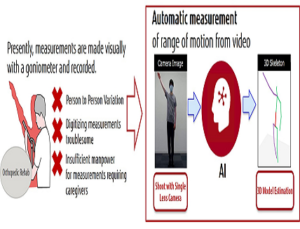
Fujitsu announced the launch of a new AI-powered physical rehabilitation solution in Japan, the “FUJITSU Healthcare Solution HOPE ROMREC”, offering medical institutions like hospitals and clinics a powerful new tool for rehabilitation and orthopedic therapies. The solution leverages a new AI technology to automatically measure the range of motion of the shoulder and elbow joints from videos of patients’ rehabilitation sessions.
“HOPE ROMREC” is a solution that automatically measures, records, and visualizes the angles of a patient’s shoulder and elbow by estimating a three-dimensional skeleton from rehabilitation videos captured using a tablet device . The solution leverages an image analysis AI engine developed by Fujitsu consisting of multiple AI image recognition models. The technology offers the potential to greatly improve the efficiency of the visual measurement of a patient’s joint curvature using a goniometer, a task conventionally performed by physical therapists and occupational therapists. Ultimately, the solution will help medical professionals evaluate the effectiveness of physical and occupational therapies and determine the degree of their patients’ conditions.
Going forward, Fujitsu plans to continue strengthening the HOPE ROMREC solution and increase the number of measurement sites for range of motion detection. Fujitsu additionally plans to incorporate functions including automatic measurement of range of motion by simply sending video taken by a patient at home to their hospital or clinic, contributing to the realization of remote rehabilitation.
Background
In rehabilitation therapy, measuring range of motion is necessary to determine factors inhibiting joint movement, evaluate the effects of physical and occupational therapy, and determine the extent of a patient’s condition. Physical therapists and occupational therapists make these measurements visually using goniometers, etc., however, which contributes to variation in measurement values from person to person. Conventional automatic measurement of range of motion demands special equipment, such as an acceleration sensor, which have not yet been widely implemented in the field. In addition to the system input work of measurement values, therapists now must also carry out extensive disinfection in rehabilitation areas to prevent COVID-19 infections , increasing the burden on medical facilities.
To address these challenges, Fujitsu has developed the HOPE ROMREC solution, which automatically measures the range of motion of the shoulder and elbow joints by analyzing videos of patients’ rehabilitation with AI. Sales of the new solution will begin in Japan on February 24.
Key Features of the New Solution
1. Automatic measurement of patient’s range of motion with image analysis AI engine
Using an image analysis AI engine, which combines multiple AI image recognition models with previously learned motion patterns of a person’s shoulder and elbow joints, it’s possible to replicate a three-dimensional skeleton from a patient’s rehabilitation video and automatically measure angles in a total of 16 motion directions for the shoulder and elbow. Therapists take the rehabilitation videos with a tablet’s camera and send them to a dedicated PC equipped with an image analysis AI engine.
The measured values are recorded as data and can be displayed as a time-series line graph, making it easy to grasp the effect and transition of individual patients’ rehabilitation.
It eliminates the need for accelerometers and joint markers on patients, as well as multiple cameras and specialized equipment such as infrared laser radar, which are required for conventional automated measurements of range of motion.
This greatly increases the efficiency of therapists’ work, which uses goniometers to visually measure a patient’s range of motion, and helps assess the effectiveness of physical and occupational therapy and determine the degree of the patient’s condition.

2. Voice input function of the measured value
In order to reduce the workload of therapists in rehabilitation areas other than shoulders and elbows, for which measurements can be automatically taken for the range of joint motion from video, the system is equipped with a voice input function that enables the tablet to automatically record and recognize when the user speaks the body part, direction of movement, and measurement values measured by their goniometer.
This eliminates the need for note-taking and system input of measurement values that therapists typically perform, and enables measurement results to be recorded efficiently and quickly.

3. Easily link data with electronic medical records systems
Since the measurement data can be exported as CSV data, it can be easily incorporated into an electronic medical record system and a medical certificate preparation system, and it can be utilized for higher quality rehabilitation treatment based on the patient’s treatment results and treatment plans.
Pricing and Availability
| Solution, Service Name | Pricing (excl. tax) | Sales Date | Date Available |
| FUJITSU Healthcare Solution HOPE ROMREC V1 (image recognition) (Incl. 1 client) | 860,000 JPY | February 24 | March 5 |
| FUJITSU Healthcare Solution HOPE ROMREC V1 (voice input) (Incl. 1 client) | 860,000 JPY | ||
| FUJITSU Healthcare Solutions HOPE ROMREC V1 1 additional client fee | 230,000 JPY |


















